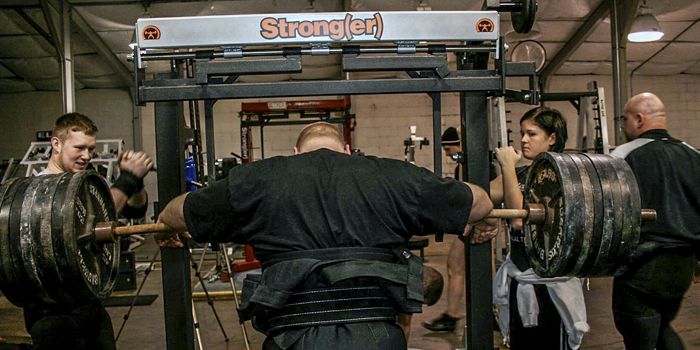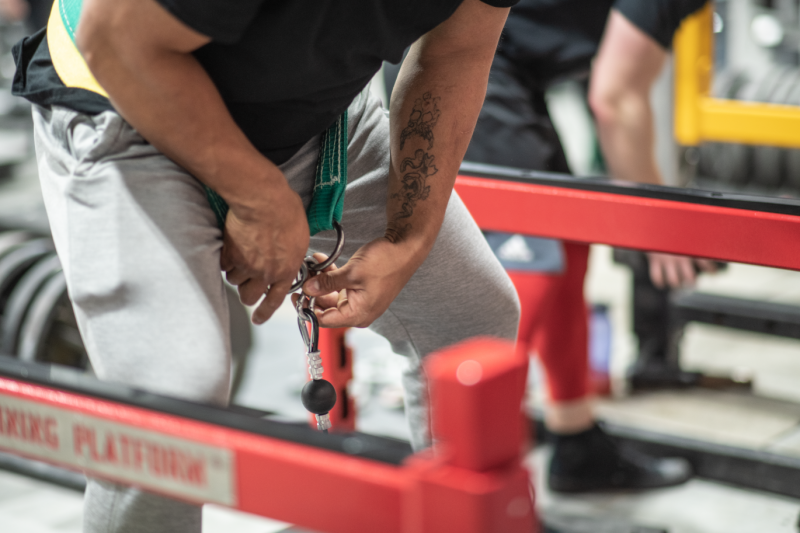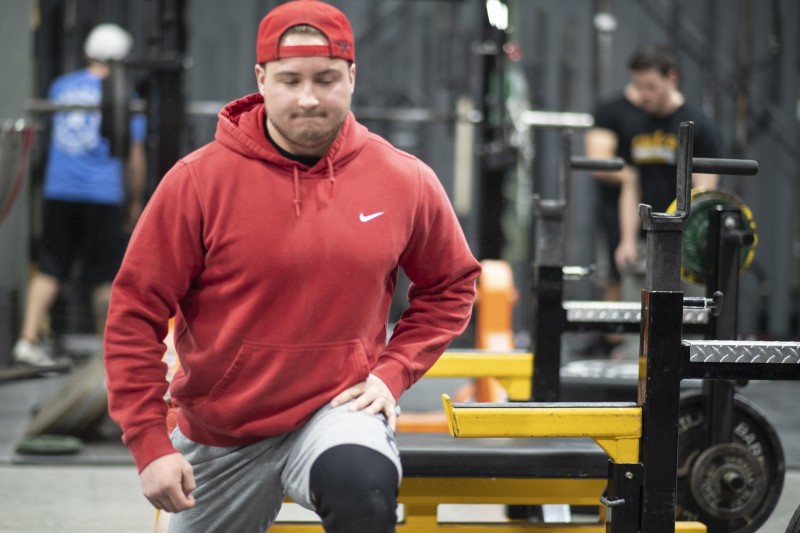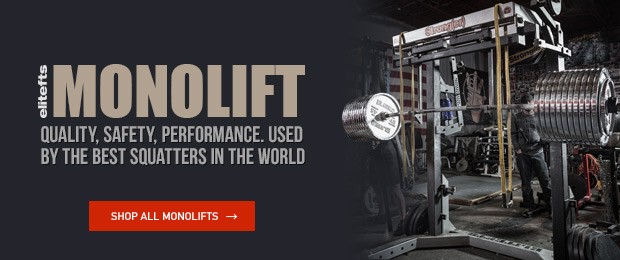
There I was, sitting at home again with an aching back. I couldn’t really walk, sleep, sit, or take a shit without feeling that knife being slowly slid into my erectors. I needed to do something to get back on track. I missed lifting so much. I just couldn’t quit. But what was the answer? Linear periodization wouldn’t help with recovery. Block periodization killed me. This is when an idea came to my head. The idea had broken my lower back in three weeks the first time I tried it. Of course, that was my fault, not the program. Clearly, I had no clue what I was doing. But can I be that stupid to give it a shot again? Of course!
This was the moment I grabbed Science and Practice of Strength Training and Supertraining again, and started listening to Louie Simmons’ Westside Barbell podcasts, elitefts Table Talk videos about the conjugate system, Mark Bell’s thoughts on the Westside system, and anything that seemed relevant. I wanted to learn as much as I could about the conjugate method again. What I knew already was that I had to rotate exercises, max out two times a week, and do dynamic what-the-fucks two times a week. As I was gathering knowledge, making all my and notes trying to figure out how I was going to get out of this hole, it all started to come together — at least I thought.
WATCH: Table Talk — Conjugate Method Training Tips
I started writing the first few weeks: four training days a week, two being max effort and two being dynamic effort days with some accessories. Abs all day long, and something that makes me stronger. I did this for about 14 weeks with huge success. I was breaking PRs like never before (24 to be accurate, although I did not even know what I was doing). Then I started reading the Westside Barbell Book of Methods, and it all just made sense. I figured out I was doing about 30% or 40% of it correctly, and I was completely happy about it, but there was that 60% that was just missing.
I realized I don’t just have 20 to 30 exercises to choose from in the squat or bench press; I have more than 100 or even 200 to max out. I realized I don’t have to be 100% strict to train my biceps, lats, shoulders, and triceps for the same amount and pay the same attention to them, or that I don’t have to do three-week pendulum waves doing some accessories I hate that are not even useful. And, maybe one of my greatest lessons was to learn what speed-strength is, and what the purpose of speed days with bands is.
So, I’ve learned a lot. Here are the biggest benefits, from my point of view, of using the conjugate style training:
Program Background
- The program has two max effort (ME) days and two dynamic effort (DE) days, being the same body parts possibly 72 hours apart (i.e. ME squat on Monday, then DE lower body no sooner than Thursday).
- I did a squat max on week one, then a deadlift on week two, a squat again in week three, and so on. Originally it is suggested to do heavy good mornings maybe two times in five or six weeks, but as I got injured in them years ago, I decided to skip that and do good morning variations twice a week with hypers and reverse hypers for volume.
- For the bench, I max every week without exception. The only thing I pay attention to is the intensity loading; I rotate exercise variations so that a heavy week is followed by a light week. I do pin press for a one-rep max (1RM) that is followed by seated press for a three-rep max (3RM) that is much less weight on the bar.
- As a raw lifter, I was using three, four, and five-rep maxes on max effort days first. It made me get familiar with what I was doing, and this was a great idea. I did not overtrain but got a perfect sense of how it was going to look. It provided me with volume and a decent intensity as well, as I was coming back from injury.
- After 14 weeks I’ve started intensifying my training. All I did was 1RMs — hardly any exceptions occurred.
- I raised my confidence like hell. As I don’t do competition lifts on a regular basis, I had to build the confidence in myself that I am getting stronger in them, and voila, there it was. I was getting so strong I out-lifted my competition lift PRs easily with just variations I suck at.
Max Effort Training
- Max effort days should be a training max. This means you should not hype yourself up or go #beastmode or #savage. Never do that! Leave the emotions and adrenaline to the competitions. Do one lift at 90%, then either 97% or a new record, and then possibly one more record. Do not hype up. Just do what you are capable of at that moment of time. There is no need for more. You just need to struggle with the weight.
- If you are lifting a 1RM or 3RM twice every week, you will get used to challenges, lifting big, and struggling with huge loads. This will make you stronger and more confident, no matter what.
- Use variations for ME training. If you don't, you will destroy yourself in four weeks or less, just as I did four years ago when first trying this method.
- Football players do drills in training; they don’t play football matches to improve. The same rule applies here. It was hard to imagine for myself how the fuck I would get stronger if I didn’t do competition squats at all, just doing some belt squats and good mornings instead. But man, it works much better than doing 100 reps weekly on the same exercise.
Dynamic Effort Training
- Dynamic effort days will not be easy. These were harder and heavier than the max effort days. First, I started with nine sets of three, then switched to 12 doubles as Louie suggested, because in a powerlifting competition you just do singles, so you are better off doing a first rep 12 times than only nine times.
- Dynamic movements should be done fast. We are using 50%, 55%, or 60% bar weight, plus 20% or 25% of bands or chains for accommodating resistance. The bar should be moving fast. If it is not fast, reduce the weight. You are not lifting for your ego; you are lifting for speed-strength, which is the ability to develop force rapidly.
- Rest periods of 40 to 60 seconds for dynamic effort work nearly gave me heart attacks in the first few weeks. Totally worth it!
- Bands are useful for raw lifters as well! Louie (and Zatsiorsky) writes about the mini-max point, and examined that a barbell loaded with weight plates is too heavy at the bottom but too light at the top. If you apply some bands, weight loading throughout the movement will be just perfect for that extra improvement.
- Another very important aspect of using bands is speed — more precisely deceleration. As you are approaching the lockout of a deadlift, bench, or squat, you will feel (no matter what) that the barbell is slowing down. Applying bands will help keep up that speed even toward the end of the lift.
Weak Points and Exercise Selection
- A chain is only as strong as its weakest link. This might sound like and indeed be a cliché, but it's true. You need to learn—and for me, this is the most exciting part—to figure out your weaknesses and address them in the proper priority, angle, volume, and loading strategy. Doing these in a way to avoid overtraining and be able to constantly get better week by week is the challenge. I have an Excel file with approximately eight worksheets containing just my weaknesses and the possible solutions, tested solutions, working solutions, reps, sets, weights, experiences. I also "change my mind” while training and modify the plan at the last second if I feel I need to.
- Box squats are damn useful. I am 100% sure I can’t perform them properly to this day, but they still have a huge carryover to my main squat without a box. You must start implementing them in your training.
- If your hips are weak, use a wide stance box below parallel, feet parallel to each other, knees out, and not going forward at all.
- If your posterior chain is weak, vary a wide and moderate stance below parallel with feet parallel to each other, have your calves touch the box, and do not let them go forward at all. You need to learn to sit back properly. If you can’t, it means your hamstrings and glutes are weak.
- If your lower back is weak, use a close stance box squat below or just at parallel.
- If your quads need love, choose pretty much any width, but stay above parallel with the box.
- Constantly rotate accessories as well. Do them for two to three training sessions and switch so you can keep up improving. One option is to do them on a weekly basis with the rotation of the pendulum waves (i.e. the first three weeks of ME upper body you do dips, then the next three weeks you change it for JM presses). Another option is to do the selected exercises on consecutive respective training: chest-supported rows on ME bench, then the same for that week's DE bench, then if you feel you can keep up you do them a third time for the following week's ME bench, then switch.
- You need to do tons of triceps work and dumbbell bench pressing! These helped me a lot in my bench.
Training Session Rules
- Training sessions should not last longer than 60 minutes. Max effort is training max, dynamic effort is all about getting work done fast, and repetition effort (accessories) is to be done very dense with short rest intervals for additional general physical preparation (GPP) increments.
- Try not to exceed five to six movements (exercises) a training session. Rather, do the main movement, a core (ab) exercise, and the rest should all be with strict focus on your weakest link in the respective movement.
- To anyone who says it can only be done with steroids, fuck off. That’s an invalid excuse; you just can’t imagine yourself lifting heavy all year long.
Learning More About the Program
- Read, educate yourself, read a bit more, and then some more, and start it all over again. One of the most important things, when you are programming for yourself, is to constantly keep improving. You can’t just lie back saying something will happen or someone will tell you something to do and you will be stronger. You need to learn to figure out solutions for problems (i.e. weaknesses, means of getting stronger, and how to implement these in your training). In my experience, you will need to read one book two to three times to understand what’s there and to be able to take reasonable notes to learn from.
- If you are programming for yourself, just as I do, it is a must to have someone on your side checking on your lifts at least occasionally. Even if you make videos, watch and analyze them millions of times. You won’t be able to notice those small segments where you are making a mistake. Having someone who knows the deal is a must!
- It’s not only for geared lifters. MMA fighters, NFL and track and field athletes do not wear powerlifting gear at a competition, but they still succeed with this method.
- I still don’t know anything because I’ve never been there.
Kirsztian Todik is a powerlifter and coach from Nyiregyhaza, Hungary. He trains with Mihaly Szimcsina, a former Soviet/Ukraine National Team Weightlifter, Powerlifter, and Coach. His efforts are to make powerlifting great again in his small European country.













My only concern is overtraining and not recovering quick enough - I already experienced that yesterday on a ME lower body day where my rack pull 3rm was quite lower then expected (my deadlift pr is 185kg and I could only do 3 x 170kg on a rack pull)